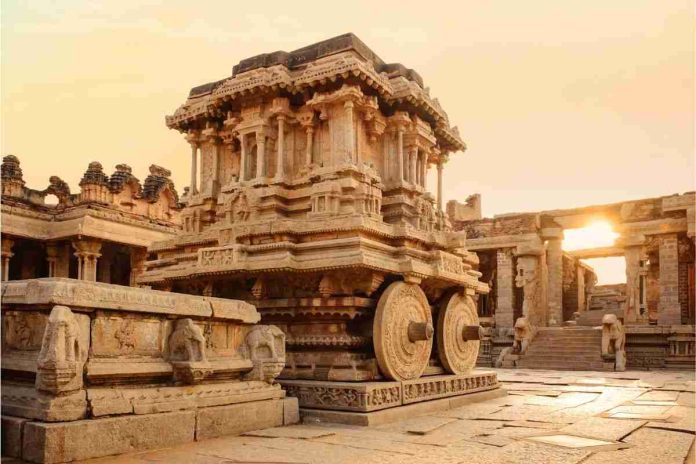Karnataka is located in the southern part of India and was formed on 1 November 1956 after getting recognition through the Reorganization Act by the Karnataka government. Before the separation, it was named Mysore. It is bordered by the Arabian Sea, Telangana, Tamil Nadu, and Andhra Pradesh.
This place has its heritage, history, and prestige. It has an important place in the diversification of India as it is a rich, known place for its culture, literature, community, and various locations. It is the foremost choice of the visitor who wants to explore nature and its beauty. One should surely visit this place.
Glimpse of Karnataka in a table
| Attribute | Information |
| Country | India |
| Formation | 1 November 1956 |
| Capital | Bengaluru |
| Districts | 31 |
| Governing Body | Government of Karnataka |
| State Mammal | Elephant |
| State Flower | Lotus |
| State Tree | Sandalwood |
| Area | 191,791 square kilometres |
| Population (2023 est.) | 70 million |
| Languages Spoken | Kannada (official), English, Hindi |
| Major Rivers | Kaveri, Tungabhadra, Krishna |
| Climate | Tropical monsoon |
| Major Industries | Information Technology, Biotechnology, Aerospace, Agriculture |
| Tourist Attractions | Mysore Palace, Hampi, Coorg, Jog Falls, Bannerghatta National Park |
Capital of Karnataka
Banglore is the capital of Karnataka. It is officially known as Bengaluru. It has a population of about 10 million and is the 3 rd most populous city in India. Sometimes Bengaluru has the title of the Silicon Valley of India as it has a primary role in India’s leading information technology. Bengaluru is India’s fastest-growing metropolis.
It also contains many technical institutions like the Indian Institute of Science (IISC), the Indian Institute of Fashion Technology, the National Institute of Design, the Federal Law School of India, etc.
History of Karnataka
In the 3rd century BC, Karnataka was part of the Nanda Empire. After that, it came under the rule of Satvahanas according to the Hindu inscription. Then, the Kadampa, Ashok, and Mauryan dynasties ruled in the 5th century.
The copper coins were discovered at Banavasi. These dynasties were followed by the Kannada Empire, like Badami, Chalukyas, the Rashtrakuta kingdom, Cholas, and the Hoysala rule. After the first millennium, Hoysala gained the throne, and many kinds of literature flourished at that time. In 1565, many significant shifts occurred in Karnataka because of the fall of the Vijay Nagar Empire.
After this, the Nizams of Hyderabad, the Maratha, and the British ruled here. Also, many significant wars were fought, like the Anglo-Indian war in which Tipu Sultan died, and Mysore came under the rule of the British.
After independence, Maharaja Jaychamarajendra Wonder came to India, and in 1950, Mysore became an independent state. In 1975 Hyderabad and Madras joined the Mysore state under the State Reorganization Act 1956.
Art and culture of Karnataka
When you hear about Karnataka, you feel the ethnicity of this state has emerged in itself. Karnataka has a thriving culture with many festivals, celebrations, occasions, and art. Before the craft was usually done on walls, paper leaves, and wood, artists showed the whole process using drawing. Artistic brushes were unavailable then, so artists used brushes made of animal hair.
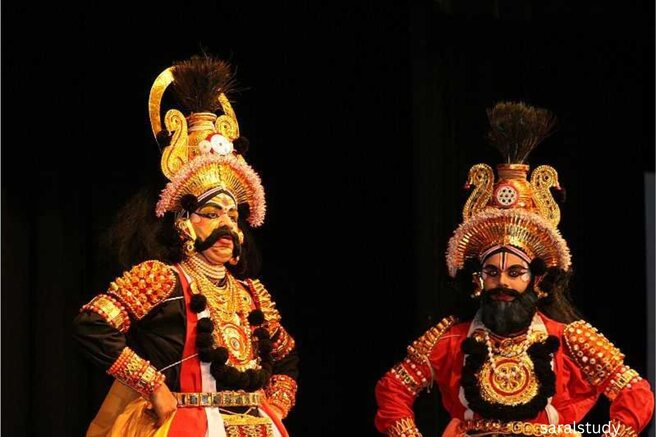
The most famous painting style was the Mysuru style which was liked by the legends and kings and was usually seen in royal castles. It is known throughout India because of its simplicity and detailing work. The paintings seen in Karnataka are approximately 150 years old, but the globe is still the same.
The tribal community covers Karnataka’s large area, and they have their own culture and customs. For example, they made Chitra mud painting, which is an art form that is famous all over the world.
Main Occupation in Karnataka
A large population of Karnataka depends upon farming for their livelihood. Despite moving to urban states, people prefer cultivating their farms. Rice is the staple food of Karnataka, and it shows excellent earnings. Karnataka is considered a rich place for its plantation and soil type. The most grown crops in Karnataka are Jowar, Ragi, Bajra, and premium plantations, such as coffee and tea, are grown in the slope areas in the Western Ghats. It is a bushy state with a lot of greenery and forestry.
The forest of Karnataka produces a large amount of precious wood and bark like sandalwood which also provides an excellent living to the locals. People also prefer working in product making through dyes, gum collection, spice extraction, etc. other than agriculture, the people of Karnataka are also engaged in manufacturing, resources-based work, transportation, and official government officers.
The local people import and export from the Arabian Sea, providing excellent earnings. Since during British rule, the Kannada officials also played a prominent role. Many people work as department offices, clerks, etc. every year Karnataka government provides a lot of vacancies for the youth.
Significant tourist places in Karnataka
Hampi
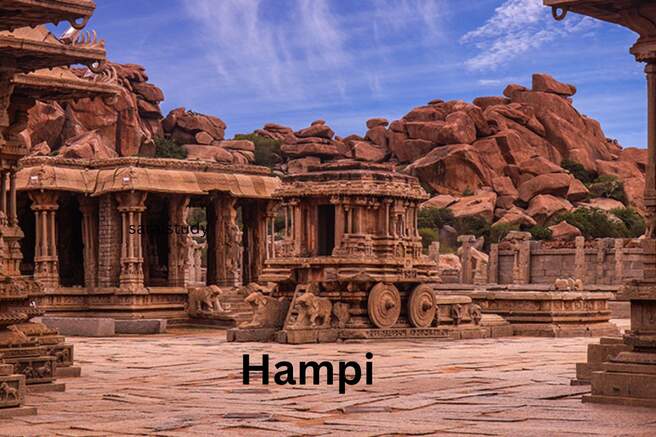
According to UNESCO, it is a world heritage site famous for its marvelous architecture and is situated on the bank of the Tungabhadra river. This place has its historical importance from the period of Vthe Vijayanagar kingdoTherehere are 500 magnificent pieces of architecture made up of rocks and stone carvings.
Mysore
Also called a city of charm and the oldest and second biggest city of Karnataka, Mysore is one of the cities which managed their old world charm. There are many impressive places, museums, temples,s and unique heritage structures. Gokarna Is a small town with the lowest situated in the north Kannada district of Karnataka, and it has a very peaceful environment. Mahabaleshwar is the famous place of Gokarna.
Jog Falls
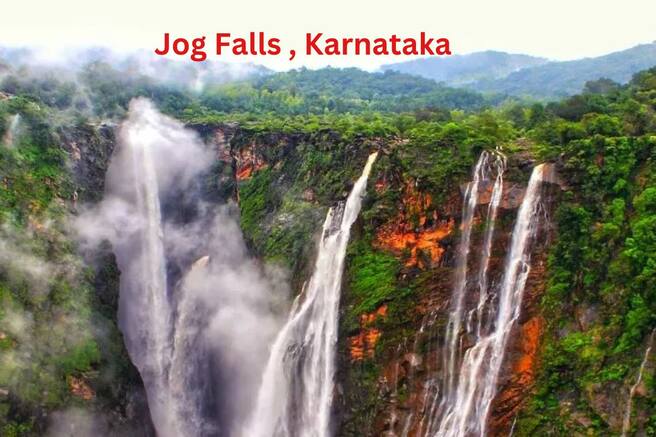
It is the third-highest waterfall in India. It is 850 feet below the ground and has a stunning viewpoint full of natural and beautiful creations.
Famous Food in Karnataka
- Neer Dosa:
-
-
- Neer dosa is a simple dish made of rice. The rice is soaked overnight, made into a paste, and cooked into dosa. Rice is the staple food of Karnataka, so this dish is readily available all over the place.
-
- Alleged:
-
-
- Alleged is a side dish served with trial cuisine. It is made of potatoes sauteed with tomato, black gram, and onion, usually spicy, as many locals like it that way.
-
- Korri Gassi:
-
-
- Korri gassi is a chicken curry with many spices and coconut. It is the most famous dish among the people of Karnataka, known for its authentic chili flavor. It is served with dosa and roti.
-
- Mysore Pak:
-
-
- Mysore Pak is a popular sweet dish made of gram flour, ghee, sugar, and milk. Its texture is soft and rich due to the use of a large amount of ghee, commonly served during Diwali and other important occasions.
-
- Haalbai:
-
-
- Haalbai is a beloved sweet dish made of rice, coconut, coconut milk, and jaggery. Its texture is a bit flowy due to the coconut milk. It is highly served during the festive season and can be eaten cold or hot as you like.
-
- Kundapura Koli:
-
-
- Kundapura Koli is a chicken curry in a different style, popular among the locals of the Mangalorean coast. It is boiled in a thick gravy of onion, ginger, garlic, tomato, other spices, and coconut milk. It is a savory dish served with roti or dosa.
-
- Rava Kesari:
-
-
- Rava Kesari is a sweet Karnataka dish made of semolina, ghee, dry fruits, water, sugar, and coloring essence. It is served on special occasions and pujas in the mandir. Semolina is roasted till it turns its color and then cooked with sugar water until thoroughly done.
-
- Kane Rava Fry:
-
- Kane Rava Fry is considered Karnataka’s most famous and authentic dish. It is made of fish coated with red paste and other spices, then covered with semolina and roasted well till fully cooked.
Climate of Karnataka
Karnataka has a subtropical climate throughout the year, experiencing four types of climate: summer, winter, monsoon, and post-monsoon. During winter, the temperature is around 80°F, while summer is humid with temperatures around 30°C. The monsoon season brings significant rainfall, about 20 inches in drier areas and 160 inches in coastal plains. Winter is relatively dry compared to other seasons.
Due to the different climates, Karnataka is divided into three meteorological regions:
- Coastal Karnataka:
-
-
- This region includes Udupi, Uttara Kannada, and Dakshina Kannada districts, receiving very high rainfall with an average of about 3456mm.
-
- North Interior Karnataka:
-
-
- This area covers Bagalkot, Belgaum, Bijapur, Bidar, Bellary, Dharwad, Haveri, Gadag, Koppal, and Raichur districts. It is an arid zone with the least amount of rainfall, about 731mm annually.
-
- South Interior Karnataka:
-
- This region includes Bangalore, Chitradurga, Chamraj Nagar, Hassan, Kodagu, Kolar, and Mysore districts. It is a semi-arid zone with an annual average rainfall of about 1286mm.
Major Rivers in Karnataka
The major rivers of Karnataka originate from the Western Ghats and join the river Kaveri near Krishna Raj Sagar. The main tributaries of the Kaveri river are Krishna and Kabini, which originate in Kerala and flow eastward.
- Tungabhadra:
-
-
- Starts from Shimoga district, flows towards the Deccan plateau, joins the Krishna river in Andhra Pradesh, and eventually reaches the Bay of Bengal.
-
- Ghataprabha:
-
-
- Originates from the Western Ghats in Belgaum district, flows eastward, and joins Krishna.
-
- Malaprabha:
-
-
- Starts from the Western Ghats, flows northeast, and joins the Krishna river at Kudalasangama.
-
- Bhima:
-
-
- Originates from Bhimashankar, flows through Maharashtra and Karnataka.
-
- Mantra:
-
-
- A tributary of the Godavari river, originating from the Balaghat range.
-
- Palar:
-
-
- Starts from the Talagavara district, flows through Karnataka, Andhra Pradesh, and Tamil Nadu.
-
- West-Flowing Rivers:
-
- Mandavi: Originates from the Western Ghats, flows towards Karnataka and Goa.
- Gangavalli: Originates from the Southwestern Ghats.
- Sharavathi: Starts from Ambuthirtha in Thirthahalli Taluk, flows northwest, forming Jog Falls before reaching the Arabian Sea.
Famous Personalities of Karnataka
- Ambareesh:
-
-
- Born on May 29, 1952, and passed away on November 24, 2018. He was an Indian National Congress leader and an actor. His full name was Malavalli Huchchegowda Amarnath.
-
- Basavanna:
-
-
- An Indian philosopher who fought against the caste system and spread awareness among people.
-
- Akka Mahadevi:
-
-
- A significant revolutionary of the Bhakti movement from Karnataka.
-
- Sarvajna:
-
- A Kannada poet and philosopher.
Festivals of Karnataka
- Pattadakal Dance Festival:
-
-
- Celebrated in towns established in the 7th century, recognized as a world heritage site by UNESCO.
-
- Hampi Festival:
-
-
- Also known as Vijaya Utsav, it is the largest cultural program in South India, held in Hampi, a UNESCO World Heritage site.
-
- Kambala Festival:
-
-
- A buffalo race held annually by farming communities in South Kannada and Udupi districts celebrated between November and March.
-
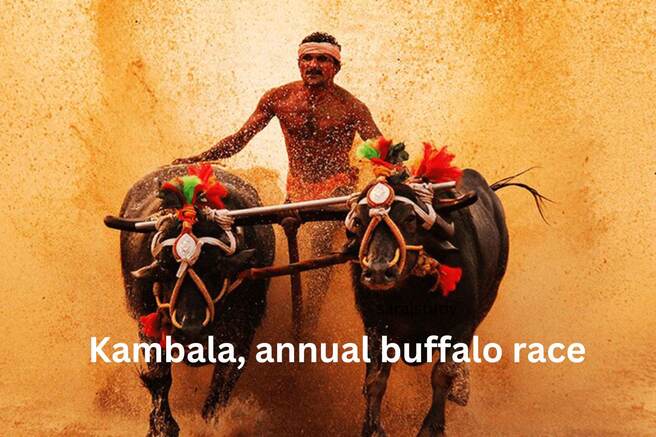
- Makar Sankranti Mela
-
-
- Held every January at Rajgir, where devotees offer flowers to deities and dip in holy water.
-
- Ugadi:
-
- Also known as Gudi Padwa, marking the New Year as per the Hindu calendar, believed to be the day Brahma created the universe.
Costumes of Karnataka
Karnataka’s traditional dresses reflect simplicity and elegance. Women usually wear sarees (Kanjiwaram, silk, Kasuti embroidery, Guledgunda), while men wear dhoti and kurta.
Flora and Fauna of Karnataka
Karnataka’s forests cover around 43,356.47 square km, featuring evergreen, semi-evergreen, moist deciduous, dry deciduous, thorny forests, shrubs, and grasslands. The Western Ghats are home to eucalyptus, teak, rosewood, and casuarina trees, as well as species like Iphigenia Mysorensis, Derris Indica, and more.
The fauna includes 25% of India’s elephants and 20% of tigers. Other mammals include leopards, slender loris, gaur, wild pig, pangolin, Malabar giant squirrel, mouse deer, bonnet macaque, common langur, and barking deer. Bird species include ruby-throated bulbul, Indian shama, Malabar whistling thrush, and more. Reptiles like crocodiles, tortoises, lizards, chameleons, and snakes are also found.
Demographics of Karnataka
According to the 2011 census, Karnataka’s population is around 61,095,297, with 30,966,657 males and 30,128,640 females. Approximately 38.6% live in urban areas, while the rest reside in rural areas. The literacy rate is 75.36%, with male literacy at 82.47% and female literacy at 68.08%. The state’s birth rate is 2.2%, death rate is about 0.7%, infant mortality rate is 5.5%, maternal mortality rate is 0.2%, and fertility rate is 2.2%.
Language of Karnataka
Karnataka has a wide variety of linguistic ethnicities; since the separation, Karnataka has been the home of many tribal and other communities. The ancient culture of the state lies in its language and speaking features. Karnataka is a centre of living for Tuluvas, Kodavas, and Konkanis. Some most common languages of Karnataka are as follows:
- Kannada: Kannada is the native language of Karnataka and is spoken by almost 72% of the state’s population. Kannada-speaking people are the most dominant group in society. It is the administrative language and is commonly used for all document-related purposes. It is considered the classic language, as most officers and other officials are the users.
- Konkani: Uttar Karnataka covers a large number of Karnataka’s Konkani-speaking population. Konkani speakers cover almost 76% of the population, a significant amount. The Konkani speakers are the prime people in Karnataka.
- Tulu: Tuluvas is the native language of the people of Tulu, the dominant-speaking group of Karnataka. According to a recent census, the Tuluvas cover almost 2.30% of the total percentage of Karnataka.
- Byari: Byari is the prime speaking language among the Muslim Community of Karnataka in Dakshin Karnataka. This language has different linguistic features, such as Arabic, Urdu, and Kannada. It covers a small population of around 8.85% of the state.
- Kodava: It is the least-known language among the people of India; many people didn’t even hear about this. It is considered one of the native languages, which is usually used by a significantly small percentage of the population of Karnataka. Since its abundant language, many communities such as Banna, Meda, and Kodava are the prime users.
- Urdu: After Kannada, Urdu is considered the most spoken language of Karnataka, covering a large population of around 9.72% of speakers. The estimation of the speakers is uneven as people are wholly distributed among the state’s different regions.
Important Lakes and National Parks in Karnataka
-
Krishna Raja Sagara Lake:
- It is the most famous and visited place in Karnataka. The dam was built on this lake, and the dam and lake are both famous due to the Brindavan Garden and the Barrie.
-
Karanji Lake:
- It is situated near the Chamundi Betta, and this lake is enclosed in the zoo area. This place is famous for the migratory bird. Several species made this lake their temporary and permanent home. Apart from the lake, Chamundi hills and Chamundi temple is also a wonderful place.
-
Herbal Lake:
- It is the most popular place in Bangalore and is located near the national highway number 7, situated in the north of Bangalore. It is an artificial lake built by blocking the natural valley system and was established in 1537.
-
Nagarhole National Park:
- It is located in the Nilgiri biosphere reserve and is also known as Rajiv Gandhi National Park, the largest wildlife sanctuary in South India. This place is famous for wildlife spotting, vehicle safari, boat safari, and coracle rides.
-
Bandipur National Park:
- This place is popularly known for its tigers. This park came under the scheme of the Tiger Project in 1974.
-
Kabini Wildlife Sanctuary:
- It is a private hunting ground for the Maharajas of Mysore. It is one of the popular sanctuaries in Karnataka, situated nearly 80 km from Mysore and about 250 km from Bangalore. The sanctuary is famous for leopard, cheetah safari, sambar, panther, and boat ride.
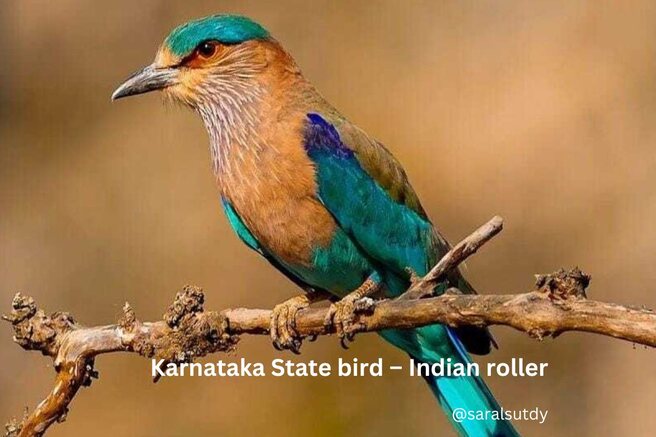
Government and Administration
Karnataka government contains two houses (Lok Sabha and Rajya Sabha), the legislative assembly, and the legislative council. The member strength of the legislative assembly is 224, who are elected for a limited tenure of five years. The legislative committee is a permanent body consisting of 75 members, with one-third of members retiring yearly.
The government of Karnataka is headed by the chief minister, chosen by the ruling party member, and exercises almost all executive powers. The governor is the constitutional and formal head of the government, which the president appoints for five years.
The 28 members were elected from Lok Sabha and 12 from Rajya Sabha; however, the Karnataka estate is divided into four revenue divisions, 49 subdivisions, 31 districts, and 175 talukas.
Economy of Karnataka
56% of the population is included in agricultural work. Much of the agriculture depends on the southwest monsoon. Only 26% of the sown area is irrigated, and Karnataka is a large manufacturing hub. Karnataka also contains large private industries like Hindustan Aeronautical Ltd, National Aerospace Laboratories, Bharat Heavy Electricals Limited, and Bharat Earth Movers Ltd.
Many science and technology centres, such as the Indian Space Research Organization, Central Power Research Institute, Mangalore Refinery, and Petrochemical Limited, are oil refineries. Karnataka is the largest bio cluster, with 60% of biotechnology firms. Seven Indian banks are located here Canara Bank, Karnataka Bank, ING Vysya Bank, and State Bank of Mysore. It is the headquarters of India’s silk industry.
Conclusion
Karnataka is India’s oldest civilization, containing many different religions, traditions, and cultures. Karnataka is always on top of the food list, tourist places, and most important festivals. It covers a small area of India, but it shows a significant and incredible impact on its prosperity worldwide.
FAQs on Karnataka
1. Who was the most significant coffee exporter in India?
Karnataka is the largest producer in India. The first plantation was cultivated in Chikkamagaluru.
2. Which is the second-highest plunge waterfall, and where is it located?
The second-highest plunge was the Jog Falls, situated in Karnataka.
3. Where was the Gomateshwar statue situated?
It is situated in Shravanbelagola, and it is a giant monolith statue that is made up of granite.

